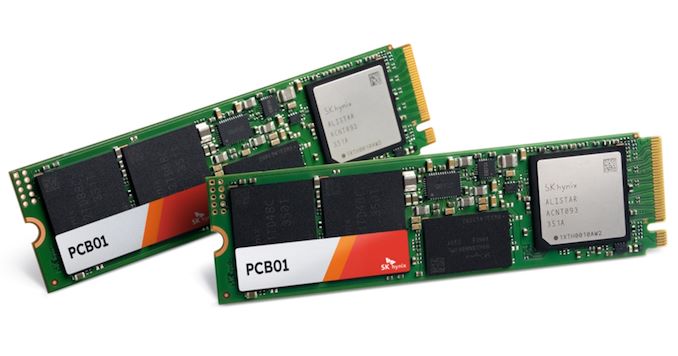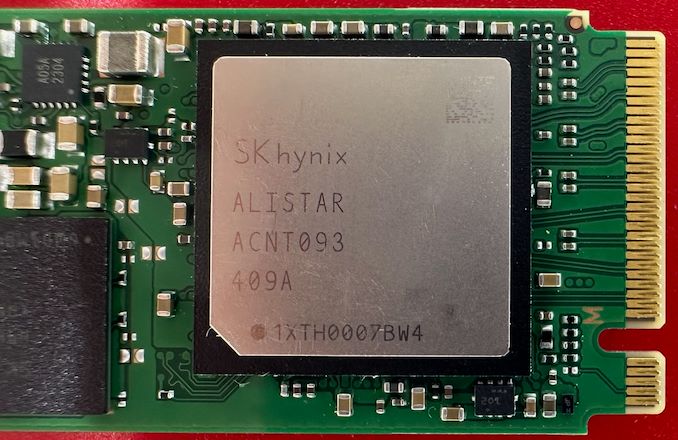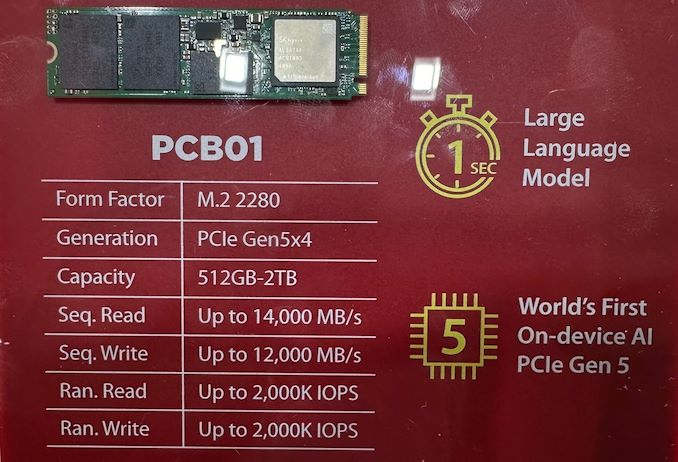SK hynix Wraps up Dev Work on High-End PCB01 PCIe 5.0 SSD for OEMs, Launching Later This Year
by Anton Shilov on June 29, 2024 11:00 AM EST
SK hynix early in Friday announced that the company has finished the development of it's PCB01 PCIe Gen5 SSD, the company's forthcoming high-end SSD for OEMs. Based on the company's new Alistar platform, the PCB01 is designed to deliver chart-topping performance for client machines. And, as a sign of the times, SK hynix is positioning the PCB01 for AI PCs, looking to synergize with the overall industry interest in anything and everything AI.
The bare, OEM-focused drives have previously been shown off by SK hynix, and make no attempt to hide what's under the hood. The PCB01 relies on SK hynix's Alistar controller, which features a PCIe Gen5 x4 host interface on the front end and eight NAND channels on the back end, placing it solidly in the realm of high-end SSDs. Paired with the Alistar controller is the company's latest 238-layer TLC NAND (H25T1TD48C & H25T2TD88C), which offers a maximum transfer speed of 2400 MT/second. Being that this is a high-end client SSD, there's also a DRAM chip on board, though the company isn't disclosing its capacity.
As with other high-end PCIe 5.0 client SSDs, SK hynix is planning on hitting peak read speeds of up to 14GB/second on the drive, while peak sequential write speeds should top 12GB/second (with pSLC caching, of course) – performance figures well within the realm of possibility for an 8 channel drive. As for random performance, at Computex the company was telling attendees that the drives should be able to sustain 4K random read and write rates of 2 million IOPS, which is very high as well. The SSDs are also said to consume up to 30% less power than 'predecessors,' according to SK hynix, though the company didn't elaborate on that figure. Typically in the storage industry, energy figures are based on iso-performance (rather than peak performance) – essentially measuring energy efficiency per bit rather than toal power consumption – and that is likely the case here as well.
At least initially, SK Hynix plans to release its PCB01 in three capacities – 512 GB, 1 TB, and 2 TB. The company has previously disclosed that their 238L TLC NAND has a capacity of 512Gbit, so these are typical capacity figures for single-sided drives. And while the focus of the company's press release this week was on OEM drives, this is the same controller and NAND that is also going into the company's previously-teased retail Platinum P51 SSD, so this week's reveal offers a bit more detail into what to expect from that drive family as well.
Specs aside, Ahn Hyun, the Head of the N-S Committee at SK hynix, said that multiple global CPU providers for on-device AI PCs are seeking collaboration for the compatibility validation process, which is underway, so expect PCB01 drives inside PCs in this back-to-school and holiday seasons.
"We will work towards enhancing our leadership as the global top AI memory provider also in the NAND solution space by successfully completing the customer validation and mass production of PCB01, which will be in the limelight," Ahn Hyun said.
Source: SK hynix












8 Comments
View All Comments
Samus - Saturday, June 29, 2024 - link
Sweet. My go-to SSD since the PC711 OEM drives and the P31 retail version. Fantastic, reliable, efficient drives.ZeDestructor - Sunday, June 30, 2024 - link
Why oh why are there no 4TB or 8TB SKUs? I adore my P31 Gold, but at 2TB it's just not enough capacity with how I use my laptopsDrkrieger01 - Sunday, June 30, 2024 - link
Likely due to their being little demand for this capacity from OEMs. Also, the OEMs can get away with charging a 'premium' for a 'branded' drive. 🙄PeachNCream - Thursday, July 4, 2024 - link
That's because people buying products are inexcusable morons that deserve every bit of the miserable, silly world they've fashioned for themselves through their own collective and individual stupidity.James5mith - Monday, July 1, 2024 - link
At this point with 8TB drives based on QLC, we could have a 2TB drive running in pure SLC mode to keep the performance permanently high.No need for a pseudo-SLC caching mode. Just SLC mode operation over the full 2TB capacity.
PeachNCream - Tuesday, July 2, 2024 - link
This! Though in my case it's not really a performance concern. I'd like the longevity of SLC or at least MLC NAND. If we're going to be stuck with garbage solid state flash, at least send us a little bit of endurance. It's absurd that an individual memory cell is rated at 600 p/e cycles for TLC and QLC reduces that to about 300 or fewer p/e cycles before an individual cell is inoperable. That's just lovely when PCs are constantly writing swap, web cache, and other nonsense to storage.SanX - Tuesday, July 2, 2024 - link
My suspicion is that avtual endurance figures companies claim for their NVMe are even lower, much lower than those petabytes per week numbers. One of my 3- 4 years old high end WD Black drives switched to readonly mode while the other stopped to load OS. That's despite massive forced cooling heatsinks with fans i use on NVMes. All companies have to stop their absurd TLC/QLC madness reducing longevity by an order of magnitude compared to SLCSamus - Tuesday, July 2, 2024 - link
Samsung and some other ODM's still have a few MLC drives just for this reason. But it would be amazing to get an SLC drive even in 1TB capacity as a system drive, even if it sold for the price of a 4TB QLC drive. I wonder if there is a way to modify the NAND translation in firmware for a user to convert a drive between states.